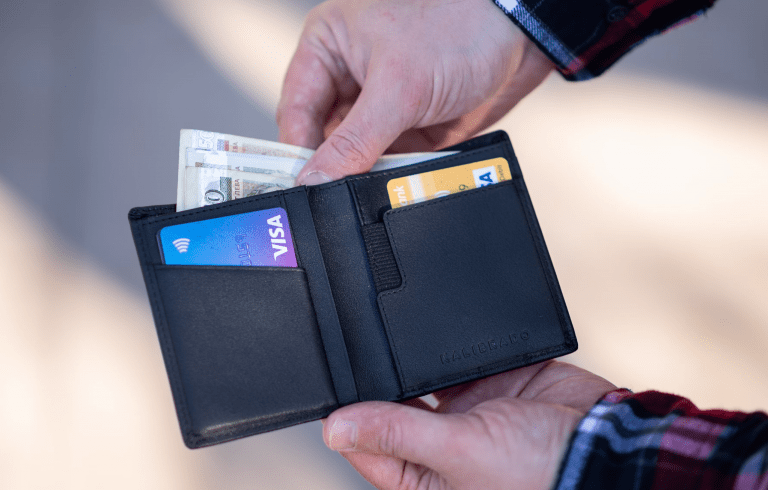I won’t stand here pretending to be holier than thou when it comes to debt issues. Credit card debt has been a persistent adversary in my life. It got so dire that I had to swiftly learn how to break free from its clutches—and I did! However, that doesn’t mean I didn’t make plenty of mistakes while overcoming the massive credit card debt I faced.
Through it all, I learned how to stay afloat and keep my head above water. And it all began with figuring out how much credit card debt is too much for you! We’re all different, and what might be considered too much for me could be a mere blip on the financial radar for someone else. Conversely, it could plunge another person into bankruptcy.
So, for you, how much credit card debt is too much? You might be in the danger zone when you notice:
- Struggling or unable to make minimum credit card payments each month
- Most or all of your monthly payments going toward credit card debt interest
- Your credit card balance increasing every month
- Credit card debt preventing you from affording most essential needs
In essence, if your credit cards have transformed from a convenience to a financial burden, you might indeed have too much credit card debt.
Signs You Have Too Much Debt
Now, let’s delve into some technicalities. I know, I know—nobody likes doing homework. But this is crucial; it’s how credit companies and credit rating agencies determine how much risk you pose, influencing how much credit you can access and at what interest rate.
Do you know how important this is?
You can use three primary ratios to determine if you’re carrying too much credit card debt: the credit utilization ratio, debt-to-income ratio (DTI), and credit card debt ratio.
Let’s break them down.

Credit Utilization Ratio
The credit utilization ratio is calculated by dividing your current total credit card balance by your total credit limit.
Aside from your credit history, your credit utilization ratio is the most critical factor in determining your credit score.
For instance, if you have three credit cards with a $1,000 credit limit each, your total credit limit is $3,000. Now, let’s say you use $150 on each card throughout the month, carrying the same credit card balance. Your credit utilization ratio would be $450/$3,000 = 0.15, or 15%.
Ideally, your credit utilization ratio shouldn’t exceed 30%; otherwise, it starts negatively impacting your credit score.
Debt-to-Income Ratio (DTI)
Also known as DTI, the debt-to-income ratio is what lenders use to determine if they should give you more money. Generally, lenders are hesitant to extend credit to someone already burdened with too much debt, deeming them risky.
The DTI is typically calculated by dividing your total monthly debt payments by your total gross (pre-tax) monthly income.
DTI =
Your total monthly debt payments
/ Your total gross monthly income
In this case, your gross monthly income is pre-tax, and your total monthly debt payments include anything that takes longer than six months to repay. This usually encompasses:
- Insurance
- Mortgage
- Property taxes
- Rent
- Student loans
- Car loans
- Credit card debt
- And most other personal loans
In terms of DTI, anything above 43% is considered too risky.

Credit Card Debt Ratio
Among the three ways to determine if you’re carrying too much credit card debt, this is the simplest and most effective for you (the others are more inclined toward how credit card companies or lenders assess your creditworthiness).
Your credit card debt ratio is calculated by dividing your total monthly credit card payments by your total net monthly income.
Credit Card Debt Ratio =
Your total monthly credit card payments
/ Your total net monthly income
Your net income is what’s left after taxes and other mandatory deductions. Essentially, this is the money you have to spend, and you use it to pay your credit card bills.
The idea here is to always keep this ratio below 10%! In a nutshell, if your net income is around $1,000 per month, the highest credit card debt you should carry in that month shouldn’t exceed $100, or 10% of $1,000.
How to Break Free from Credit Card Debt
Carrying too much credit card debt comes with consequences:
- Your credit score takes a hit, making it challenging to secure good, affordable credit in the future
- You accumulate substantial interest, pushing you deeper into debt
- You’re unable to afford things you like and need, impacting your mental well-being
If you find yourself burdened with too much debt, finding a way out is crucial. Here are some suggestions:
- Gain Comprehensive Insight: List all your income sources (monthly), all expenses, and all debts. This provides a clear understanding of your financial situation.
- Consolidate Your Debt: Attempt to consolidate all your debts onto one credit card, choosing the one with the lowest interest rate, and work on eliminating other debts.
- Create a Budget: By now, you all know how passionate I am about budgeting. I find it to be one of the best ways to manage finances effectively.
- Seek Professional Help: If all of this feels overwhelming, consider seeking professional help from financial advisors or accountants who can provide credit counseling. While it might seem like adding more debt initially, paying for credit counseling fees in the long run might help you break free from debt and lead a more financially healthy life.













+ There are no comments
Add yours